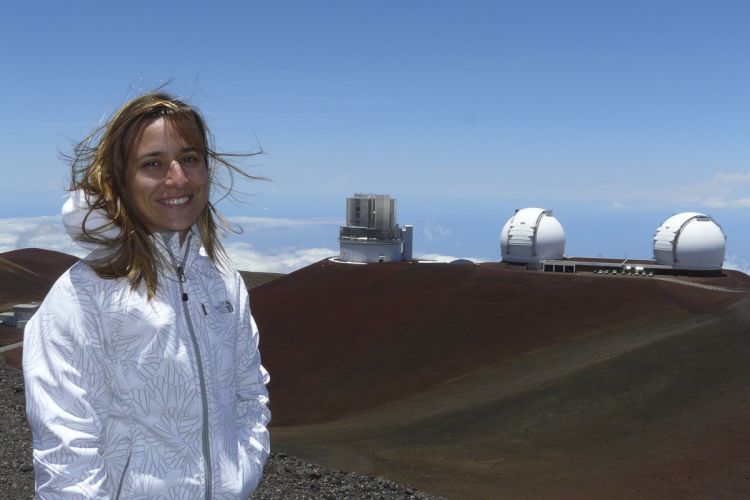Breadcrumb
Pacific professor searching for answers to galaxy formation

Pacific physics professor Elisa Toloba at W. M. Keck Observatory
Much like the eternal question—which came first: the chicken or the egg? —scientists are debating how galaxies can exist if they do not have any dark matter, the mysterious substance thought to compose up to 27% of the makeup of the universe.
This is one of the questions University of the Pacific physics professor Elisa Toloba, with the support of her students, is trying to answer by analyzing galaxies in the Virgo Cluster. The team has found that some ultra-diffuse galaxies, which have extremely low luminosity, may appear to be dark-matter free.
"It is a bit contentious in the scientific community whether or not these galaxies have dark matter," explained Toloba, who has a natural intellectual curiosity and a passion for research. "It's established you first need to have dark matter and then a galaxy will grow inside that dark matter halo. So, if a galaxy does not have dark matter, how was it formed?"
Dark matter doesn’t emit light and can’t be directly observed with any of the existing tools scientists have. Thus, dark matter is undetectable directly, but it does interact with ordinary matter. It exhibits measurable gravitational effects on large structures in the universe such as galaxies and galaxy clusters. Hence, scientists are able to map the distribution of dark matter in the universe, even though they cannot see it directly.
Toloba's research on dark matter and galaxies began with the Virgo Cluster, which is the closest cluster of galaxies to the Milky Way, and encompasses thousands of galaxies that live together in a region of the sky in the direction of the Virgo Constellation. Among her team of scientists, she is leading the effort for the spectroscopy, which measures the internal properties of the galaxies including the dynamics and the dark matter.
Toloba visited the W. M. Keck Observatory, a two-telescope astronomical observatory near the summit of Mauna Kea in Hawaii, to observe the ultra-diffuse galaxies in the Virgo Galaxy and analyzed the data.
To understand the data, Toloba and her team began to work with astronomers at the University of California, Riverside. These astronomers used a simulation which provided a galaxy formation model that includes stellar evolution, supernova feedback, black hole growth, and mergers. Through this process the dark matter from some of these galaxies were stripped away into others.
"These simulations proved that these galaxies are now dark matter deficient, but the dark matter was there and they have now lost it," explained Toloba.
The next step for Toloba and her team is to confirm the findings of these simulations. They will spend more time at the W. M. Keck Observatory to collect additional data about the ultra-diffuse galaxies in the Virgo Cluster. Toloba is also putting together a proposal to explore these galaxies on the Hubble Space Telescope, which was launched into low Earth orbit in 1990 and can provide breakthrough astronomical research that cannot be done from ground-based telescopes.
"Hopefully there are more exciting things to discover," said Toloba. "We cannot see dark matter and still do not know what it is made of or how it is distributed. There is still so much to discover in this area."
As new data continues to be collected, Toloba will begin to take the raw data and catalogue it. At that point she will have Pacific students work with her to analyze the data and share their findings.
"I am really excited about what we could find because I believe these galaxies hold the key to understanding why the universe looks the way it does," said Toloba. "It is our job to do this research and uncover those answers."





